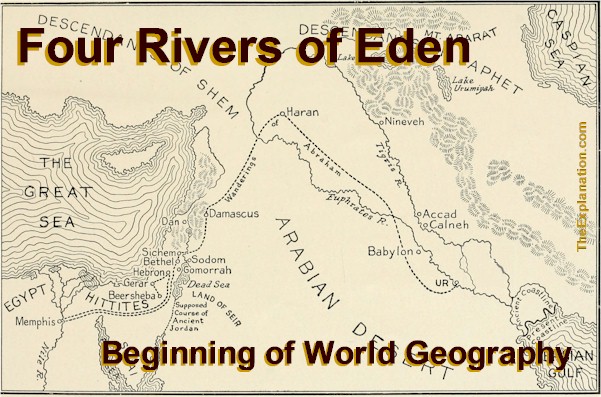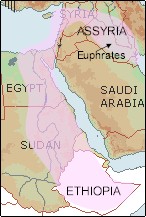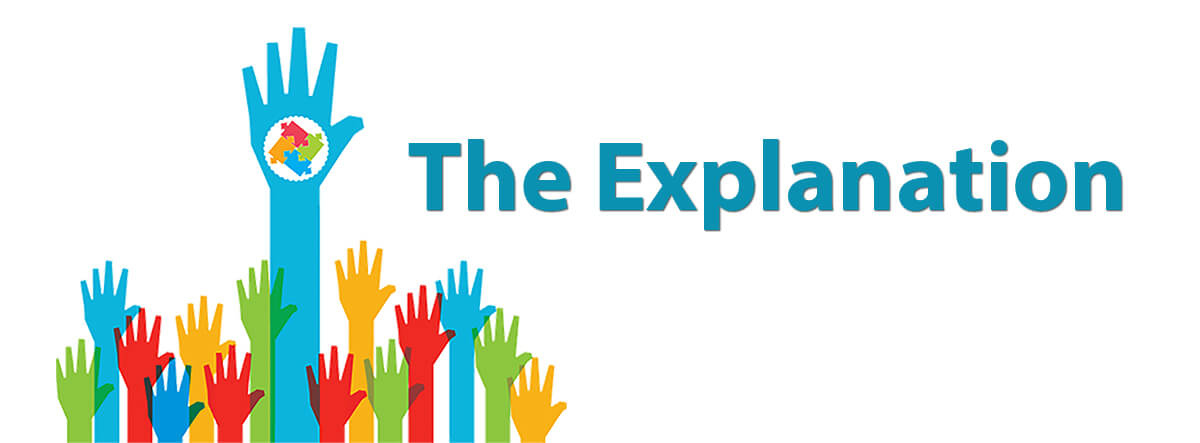Contents
Four Rivers of Eden. The first geographic features establish the basis of the entire Bible narrative from Genesis to Revelation.

Four Rivers of Eden. The beginning of world geography. Yes, we can situate this area on a contemporary world map.
The four rivers of Eden sourced from the Garden of Eden reach the Western and Eastern limits of the key nations referred to in the Bible. God abundantly watered all the nations. What happened to these majestic waterways?
(Origin of Woman, chapter 1.4)
10 And a river went out of Eden to water the garden; and from thence it was parted, and became into four heads.
11 The name of the first is Pison: that is it which compasseth the whole land of Havilah, where there is gold;
12 And the gold of that land is good: there is bdellium and the onyx stone.
13 And the name of the second river is Gihon: the same is it that compasseth the whole land of Ethiopia.
14 And the name of the third river is Hiddekel: that is it which goeth toward the east of Assyria. And the fourth river is Euphrates.
These verses plunge us into yet another controversy regarding the Bible; the relationship between the Biblical narrative and certain historical events. Two of the rivers and place names above, although used elsewhere in the Bible, remain a mystery as to their origin and location. They are open to conjecture, and it is impossible to pin these narratives down one way or another. Are they figments of imagination or facts of geography and history?
Throughout the Bible, we find examples like Noah’s worldwide flood, the Exodus with the parting of the Sea, and Joshua’s long day with which debaters have a heyday. They point to Bible fables, not to say errors, to discredit this book. There are the uninitiated as well as diploma bearing scholars who are virulent detractors of the Bible. Where does The Explanation stand on this stage?
If you’ve been reading me for some time, you’ll know. Faithful theology dictates that the Bible states the Word of God, how places exist(ed) and events took place. The Explanation does not have all the answers to all the questions, but it puts the Bible narrative first and foremost. In the last blog post, I expounded on the relationship between this river that waters Eden and the ultimate River that flows out of the Throne of God in Revelation. Both the past and future events are UNprovable. The Explanation asserts both because these phenomena are part and parcel of the Bible narrative.
It comes back to assembling our puzzle pieces perfectly, what I’m calling coherent completeness. Nobody saw God take a part of Adam out of his side and form a woman. Whoever heard of a serpent talking to Eve? On paper, a lot, if not most, of these stories sound ridiculous, like living over 900 years; belief or not, in God’s Word depends on how we approach these narratives. There are unknowns and mysteries as Paul said, “Let a man so account of us, as of the ministers of Christ, and stewards of the mysteries of God” (1 Corinthians 4:1). That is what The Explanation believes and is doing its best to expound.
There are still pieces of the puzzle, probably more than we realize, that are not entirely in place, for which we don’t understand the contours. But there are enough pieces that we can assemble to see the mind of God; the what, how, and why of His Creation of the Universe and Humankind. And that is solely true because of understanding the Bible narrative.
So let’s move on with this first geographic descriptive of the world of humankind. It is not intended to be an in-depth geography lesson where we visit and analyze all the referent verses. Suffice it to grasp an overview of the area involved. That’s what Genesis 2 is anyway, a resume with sufficient information to give us a solid foundation.
Here are the four rivers of Eden. With key 5 of the Keys to Master Biblical Hebrew in mind, consider the significance of their names. Like the Garden of Eden, these rivers have a past and future role to play in breaking forth and gushing out water to the world.
- Pison. Very enigmatic, impossible to pinpoint its whereabouts. From Strong’s H6376, it means “dispersive from the root H6335 which the KJV translates: grow up, be grown fat, spread selves, be scattered.” It refers to the result of all those who live beside the future resuscitated Pison. Havilah is an affluent area associated with gold, onyx stones, and bdellium. It is not known for sure whether the bdellium in Genesis 2:12 is a metal or a resin. Havilah is variously associated with sub-Saharan Africa, Arabia, and the Far East; this is also the name of a son of Cush (of the lineage of Ham – Gen 10:7) and a son of Joktan (of Shem – Gen 10:29).
- Gihon. Today, it is a spring in Jerusalem. From H1516 translated “break forth, labor to bring forth with the idea of water gushing out.” The translation labor to bring forth is evocative of God’s Plan, bringing forth His sons and daughters. In verse 13, Gihon compasses the whole land of Ethiopia, giving us a reliable location for this river. It runs South-West of the Garden of Eden into Africa. Ethiopia in Hebrew is Cush, H3568, the name of one of Ham’s sons. The correlation between Ethiopia and Cush is well documented; this is the identification of a geographic location both in the Bible and on today’s map.
- Hiddekel. Called id Idikla by the Accadians, the river of Idikla is associated with the Tigris which is the furthest Eastern point designated by these four rivers in Eden. It relates to Assyria, which we don’t have to present; this is a well-known Eastern People and Empire referred to over 120 times in the Old Testament. It played a prominent role in the historical ups-and-downs that befell Israel. Strong’s H804 points to Ashur, the name of a son of Shem with these uplifting translations “going, step (H838) and (call, be) bless(-ed, happy), go, guide, lead, relieve (H833).”
- The Euphrates. The most concise presentation. But, in the critical last position. Frequently in the Bible, the last mentioned in a series is the lead-in to the rest of the story. How so for the Euphrates which Strong’s definition (H6578) refers to as “to break forth; rushing?” Because the infamous city of Babylon sits majestically astride this formidable river. There are 300 references to Babylon in the Bible, only surpassed by Jerusalem referred to over 800 times. Unlike any of the four rivers or associated cities, the book of Revelation pinpoints Babylon as symbolizing the archenemy of God Himself (Rev 17:5). Babylon pictures the nations of the world, watered by the river Euphrates issuing from the Garden of Eden, God’s Headquarters.
 Branching out from Eden, there are enough known names here to situate Eden’s approximate location. Towards the East, the Euphrates river, the former Empire of Assyria and on the West the horn of Africa, Ethiopia.
Branching out from Eden, there are enough known names here to situate Eden’s approximate location. Towards the East, the Euphrates river, the former Empire of Assyria and on the West the horn of Africa, Ethiopia.
We have a western branch extended Fertile Crescent encompassing the Euphrates and Tigris rivers in the East. Then, up and around Northern Syria and down through Lebanon, Israel, further South to Egypt following the Nile down to Khartoum in Sudan and then, via the Blue Nile, on to one of its sources at Lake Tana in the Ethiopian Highlands.
The other names in these verses are conjecture, and we cannot place them with any proven accuracy. I’m certainly not trying to identify the Nile with the Pison or Gihon. There are various indications that these rivers are in the Fertile Crescent region. We can reason that the location of the territory of Eden is unquestionably narrowed down to a specific area of the globe, and we will narrow it down further.
Eden, the watershed
These five verses in Genesis 2 spend time giving details about the four rivers in Eden and some details about the surrounding area, but we don’t want to overlook the crux verse 10. It reveals the origin of the watershed: Eden. Today, as we’ve just seen, be it the Nile or the Euphrates, they have different sources. So, granted, we’re talking about two different river patterns, I refer to the names solely to situate the tableau geographically. The original Eden, the Garden, the water source and head of the four rivers have all disappeared. That founding era is gone; today’s rivers might somehow have been part of that watering system but are now just vestiges. Consider that the river Gihon encompassed Ethiopia, having its source in the Garden of Eden (Jerusalem, see Ezekiel 47:12 below) means it flowed North-South. The Nile flows South-North. These are two totally different hydrological ecosystems.
In Genesis 2, the source for all four rivers in Eden is Eden itself. It first waters the unique Garden God has planted and then spreads out to different points beyond Eden; bringing life-giving water to lands thousands of kilometers in all directions. Not only is there a Tree of Life, but there’s a River of Life because wherever it goes, it brings fertility, food, and affluence. People flock to waterside communities for commerce, culture, livelihood, travel, and a better way of life. With the Hebrew meaning of Eden being pleasure and delight, it carries that implication, not only within its territory but through its waterways, it conveys this bountifulness far beyond.
These beginning chapters of Genesis are very intense in that they contain the most fundamental principles for the correct functioning of humankind, both now and in the future. I can’t move on without reminding us that the physical portrays the spiritual. We’ve seen this with the: light=truth, darkness=destruction, air=spirit / mind, etc. These parallels continue. Water has many uses: drinking, washing, irrigation. The watershed’s spiritual counterpart is the bountifulness spreading of spiritual washing, drinking, and irrigation to which the following two verses allude.
He waters the hills from his chambers: the earth is satisfied with the fruit of your works.
Isaiah 27:33
I the LORD do keep it (His people); I will water H8248 it every moment: lest any hurt it, I will keep it night and day.
The four rivers of Eden are both real and symbolic. They portray God as Provider of both physical and spiritual benefits to ALL peoples around the world. Yes, individual people and nations are singled out, and we’ll see why, but the end of the matter is God is Creator of ALL peoples and ALL nations.
Without establishing the timeline, due to a shortage of space, here’s a future scenario, after Christ’s Return revealing the physical benefits He will spread abroad. It’s a glimpse of Earth during the Millenium. Notice, in verse 12, the source of this river is the sanctuary, the Temple of God, in Jerusalem. Engedi, mentioned in verse 10, exists to this day, I’ve been there on numerous occasions, on the Western shore of the Dead Sea. A desolation today, a paradise in the future.
6 And he [God] said to me, Son of man, hast you seen this? Then he brought me, and caused me to return to the brink of the river.
7 Now when I had returned, behold, at the bank of the river were very many trees on the one side and on the other.
8 Then said he to me, These waters issue out toward the east country, and go down into the desert, and go into the sea: which being brought forth into the sea, the waters shall be healed.
9 And it shall come to pass, that every thing that lives, which moves, whithersoever the rivers shall come, shall live: and there shall be a very great multitude of fish, because these waters shall come there: for they shall be healed; and every thing shall live wherever the river comes.
10 And it shall come to pass, that the fishers shall stand upon it from Engedi even to Eneglaim; they shall be a place to spread forth nets; their fish shall be according to their kinds, as the fish of the great sea, exceeding many.
11 But the miry places thereof and the marishes thereof shall not be healed; they shall be given to salt.
12 And by the river on the bank thereof, on this side and on that side, shall grow all trees for meat, whose leaf shall not fade, neither shall the fruit thereof be consumed: it shall bring forth new fruit according to his months, because their waters they issued out of the sanctuary: and the fruit thereof shall be for meat, and the leaf thereof for medicine.
The four rivers in Eden, The river in Zechariah 14 and the one above in Ezekiel 47 are the same river. It relays God’s Plan of spreading abundance throughout His Creation. Genesis establishes the goal right from the start, and Revelation relates its successful outcome in Revelation. We’ve come full circle. Here’s the spiritual conclusion of the story of humankind. Let me add; this is NOT the end of the entire story!
1 And I saw a new heaven and a new earth: for the first heaven and the first earth were passed away; and there was no more sea.
2 And I John saw the holy city, new Jerusalem, coming down from God out of heaven, prepared as a bride adorned for her husband.
16 And the city lieth foursquare, and the length is as large as the breadth: and he measured the city with the reed, twelve thousand furlongs. The length and the breadth and the height of it are equal.
22:1 And he shewed me a pure river of water of life, clear as crystal, proceeding out of the throne of God and of the Lamb.
2 In the midst of the street of it, and on either side of the river, was there the tree of life, which bare twelve manner of fruits, and yielded her fruit every month: and the leaves of the tree were for the healing of the nations.
See the parallel with Zechariah and Genesis. Here, the river proceeds out of God’s Throne, before, the Sanctuary and Eden (the Garden). It’s the same river but here, its spiritual with the same function of uplifting the nations. Notice the dimensions of New Jerusalem, twelve thousand furlongs, stadion in Greek (G4712). The length of a stadion is between 177 meters and 192 meters. Therefore New Jerusalem is a cube, each side is approximately 2400 kilometers! The distance, as the crow flies between Jerusalem and Babylon is 1400 kilometers. I’m not establishing geographic references, but you can see that New Jerusalem encompasses a huge area that could easily reach to Babylon with the River of Life.
The significant nations (Egypt, Assyria, and Babylon) and their cities (Memphis (Cairo), Assur, and Babylon) with which the entire Bible history of Isreal interplay are all built on major rivers. It is interesting to note that Jerusalem, the source of these rivers is perched on a mountain and has no river, not even close. This geography plays a vital role in the relationship of the people of Jerusalem, their God, and the three nations mentioned above. Just remember how the Israelites, via Jacob and his sons, went down to Egypt because there was famine in their land. Genesis 2 sets the geographic stage for our play. Today it is a rather harsh desertic area; tomorrow is another more glorious story.
We’re far from done expounding the Garden of Eden and what it portends.
This blog post is an excerpt from chapter 1.4 of the book Origin of Woman.
Dig Deeper into The Explanation
Online Study Courses to Uncover the Mystery of Adam and Eve’s Nakedness… with no fuss. Free video mini-course revealing the God-intended meaning of Scripture via Biblical Hebrew. It’s so easy, it’ll blow you away. Join now and add new motivation to your Bible study.
Join The Explanation Newsletter to stay informed of updates. and future events. No obligations, total privacy, unsubscribe anytime, if you want.
The Explanation series of seven books. Free to read online or purchase these valuable commentaries on Genesis 1-3 from your favorite book outlet. E-book and paperback formats are available. Use this link to see the details of each book and buy from your favorite store.

Since you read all the way to here… you liked it. Please use the Social Network links just below to share this information from The Explanation, Four Rivers of Eden. Beginning of World Geography

Sam, my versions of the Bible listed the last Book of the New Testament as “Revelation” (singular). In this blog are you referring to this book or all of the revelations recorded in the Bible. Could you please clarify this for me.
Thank ing you in anticipation.
John
John, Thanks for the head’s up. My mistake, I’ve corrected this.
Hi Sam, Drop me an email [email protected] and ill forward you a copy of original scripture, Old Testament…
I tell you this will surprise you! You have a good day.
Even if this concept is correct, it precedes the Creation of our ‘modern’ Earth according to Genesis 1 by millions of years. Hence, I don’t think we’re any closer to placing the remaining rivers of the Garden of Eden.